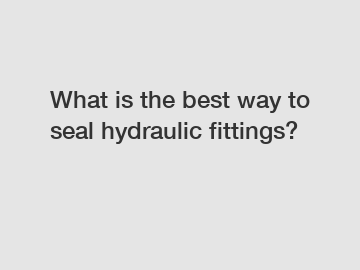Hydraulic fittings play a crucial role in ensuring the proper functioning of hydraulic systems. These fittings are responsible for connecting various components of the system, allowing hydraulic fluid to flow smoothly and efficiently. However, one common issue that many engineers and technicians face when working with hydraulic fittings is leaks. Leaks can occur at the connection points of the fittings, causing a loss of hydraulic fluid and compromising the performance of the system. So, what is the best way to seal hydraulic fittings and prevent leaks?
There are several methods and techniques that can be used to seal hydraulic fittings effectively. Each method has its own advantages and disadvantages, and the best choice will depend on factors such as the type of hydraulic system, operating conditions, and the level of expertise of the technician. In this blog, we will explore some of the most common and reliable ways to seal hydraulic fittings.
One of the most popular methods for sealing hydraulic fittings is the use of pipe thread sealants. Pipe thread sealants are chemical compounds that are applied to the threads of hydraulic fittings before assembly. These sealants create a tight seal between the threads, preventing leaks and ensuring a secure connection. Pipe thread sealants come in various forms, such as tapes, liquid sealants, and anaerobic sealants. Teflon tape is a commonly used option that is easy to apply and provides a reliable seal. Liquid sealants, on the other hand, are more viscous and can be applied to a wider range of fittings.

Another effective way to seal hydraulic fittings is the use of O-rings. O-rings are rubber or silicone gaskets that are placed at the connection points of hydraulic fittings. These gaskets create a watertight seal between the components, preventing leaks and ensuring proper fluid flow. O-rings are available in various sizes and materials to suit different types of fittings and operating conditions. When using O-rings, it is essential to choose the correct size and material to ensure a tight seal.
In addition to pipe thread sealants and O-rings, another reliable method for sealing hydraulic fittings is the use of crush washers. Crush washers are metal gaskets that are placed between the fitting and the mating surface. When the fitting is tightened, the crush washer deforms to create a seal, preventing leaks and ensuring a secure connection. Crush washers are commonly used in high-pressure hydraulic systems where a tight seal is essential. It is crucial to replace crush washers regularly to maintain the integrity of the seal.
For more demanding applications, such as high-pressure hydraulic systems or applications with aggressive fluids, metal seals may be the best option. Metal seals are typically made from materials such as copper, aluminum, or stainless steel and provide a durable and reliable seal. These seals are resistant to high pressures and temperatures and can withstand harsh operating conditions. Metal seals are commonly used in aerospace, automotive, and industrial applications where leakage is not an option.
When sealing hydraulic fittings, it is essential to follow the manufacturer's recommendations and guidelines. Improper sealing techniques can lead to leaks, system failures, and safety hazards. Before sealing the fittings, it is crucial to clean the surfaces thoroughly to remove any dirt, debris, or grease that could interfere with the seal. It is also essential to apply the sealant or gasket evenly and tighten the fittings to the recommended torque specifications.
In conclusion, there are several reliable methods for sealing hydraulic fittings effectively. Whether using pipe thread sealants, O-rings, crush washers, or metal seals, it is essential to choose the method that best suits the application and operating conditions. By using the right sealing technique and following proper installation procedures, leaks can be prevented, and hydraulic systems can operate efficiently and safely. Remember, a tight seal is the key to the smooth functioning of hydraulic systems.
If you want to learn more, please visit our website kingseal, wholesale engineering machinery seals products, Custom Rubber Products Wholesale.
Previous: None
Next: None
Comments
Please Join Us to post.
0